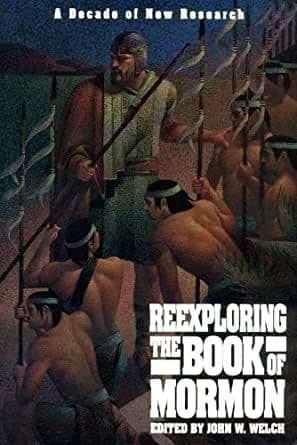Book
85 Chapters

Alma 52:1 “on the first morning of the first month”
Covenant renewal and New Year’s resolutions have more in common than meet the eye. Recent research has turned up some interesting details about the importance of New Year’s celebrations in the Bible and in the Book of Mormon. Here are a few interesting results:
In the ancient Old World, the New Year celebration was viewed as the birthday of the world. It was a day of coronation of divine and earthly kings, a day of victory over chaos, a day of renewal of covenant and the reenactment of the king’s enthronement, and a day of temple dedication and record keeping. There is good evidence that King Benjamin’s address in Mosiah 1-6 was delivered on just such a great feast day, for it included nearly all the typical ancient New Year’s features.1
Other Book of Mormon events may show the importance of New Year’s Day to those people. Imagine the confusion caused when the Lamanites awoke on New Year’s Day to find that King Amalickiah had been murdered on New Year’s Eve (see Alma 51:34-52:1). Note too the parallel timing of Teancum’s killing of Amalickiah’s brother Ammoron in Alma 62:36-39. This was the day when the king should have ceremonially conquered death and been reenthroned! Other significant events occurring around the turning of the year may be found in both the Bible and the Book of Mormon (see 1 Kings 8:2-66; Nehemiah 8:1-18; Alma 28:4-30:2; 44:24-45:1; Helaman 14:2-16:25; 3 Nephi 1:1-19; compare Exodus 40:2; Helaman 9:10).
Consider also the when of New Year’s Day as well as the what: We tend to have very short memories culturally. As Orson Pratt pointed out in Salt Lake City in 1872, from the fourteenth century A.D. until 1751, March 25 was New Year’s Day for everybody in England and the American Colonies.2 Before that, under the Julian Calendar, New Year’s Day fell on December 25, winter solstice (i.e., the shortest day of the year and the traditional birthdate in the West of Jesus—since about the fourth century A.D.), which was 22/23 of December in the later Gregorian Calendar.3 Egyptian Christians put January 6 on the winter solstice; thus, this was the Armenian and Eastern Orthodox date for Christmas. Earlier yet, the winter solstice had been the traditional birthday of the Sun-god: Mithra, Re’, Sol Invictus, etc.
The British Parliament in 1751 shortened the calendar year by eighty-four days in order to place the beginning of the year on January 1 (a neoclassical Roman revival, similar to the ancient Roman switch from March 1 to January 1, though in this case tied to the astronomical perihelion of the earth). Parliament also shortened the year 1752 by eleven days in order to finally adopt the sixteenth-century Calendar Reform of Pope Gregory XIII—and thus bring the English calendar into proper alignment with the seasons.
As if that did not play enough havoc with modern genealogical research, in 1792 the infant French Republic adopted September 22, the autumnal equinox, as its New Year, but Napoleon ordered a return to January 1 in 1805.4 In ancient Egypt, the agricultural New Year came at the heliacal rising of the star Sirius—around July 20—which coincided with the rising of the Nile River. The Babylonian and Phoenician New Year was on the first day of the first month, but in the spring in Babylon and in the fall in Phoenicia! In ancient Israel and Judah, the New Year could come with either the beginning or ending of harvest season—near either the vernal or autumnal equinox, i.e., Passover/Unleavened Bread for Israel, and Trumpets/Atonement/Tabernacles for Judah, respectively.5 This undoubtedly accounts in part for the odd fact that, for Jews, New Year’s Day comes on 1 Tishri, the first day of the seventh Jewish month (in the fall)!
The point should begin to be clear: A year need not begin when we today assume it will, and Joseph Smith apparently had no inkling of the significance of the special day upon which he removed the golden plates of the Book of Mormon from the hill near his home. It was the Jewish New Year’s Day. It was also the autumnal equinox, September 22, 1827. How appropriate for the renewed appearance of the Book of Mormon, which itself focuses on several important events at the New Year concerning covenant renewal and reenthronement of the king.
Based on research by Robert F. Smith and Stephen D. Ricks, January 1985.
1. See Hugh W. Nibley, “Old World Ritual in the New World,” in An Approach to the Book of Mormon, in The Collected Works of Hugh Nibley (Salt Lake City: Deseret Book and F.A.R.M.S., 1988), 6:295-310; John Tvedtnes, “King Benjamin and the Feast of Tabernacles,” in By Study and Also by Faith, 2 vols. (Salt Lake City: Deseret Book and F.A.R.M.S., 1990), 2:197-237; Stephen D. Ricks, “The Treaty/Covenant Pattern in King Benjamin’s Address,” Brigham Young University Studies 24 (Spring 1984): 151-62; and Frank Moore Cross on cosmic and Canaanite temple dedication in Truman G. Madsen, ed., The Temple in Antiquity (Provo: Religious Studies Center, 1984), 93.
2. Orson Pratt, “True Christmas and New Year,” Journal of Discourses 15 (29 December 1872): 261.
3. Encyclopedia Britannica, 15th ed. (Chicago), Macropaedia, 3:603; New Catholic Encyclopedia(New York: McGraw-Hill, 1967-79), 3:656.
4. Encyclopedia Britannica, 15th ed., 3:603.
5. Edwin R. Thiele, A Chronology of the Hebrew Kings (Grand Rapids: Zondervan, 1977), 14.
Book
85 Chapters
Items in the BMC Archive are made publicly available for non-commercial, private use. Inclusion within the BMC Archive does not imply endorsement. Items do not represent the official views of The Church of Jesus Christ of Latter-day Saints or of Book of Mormon Central.